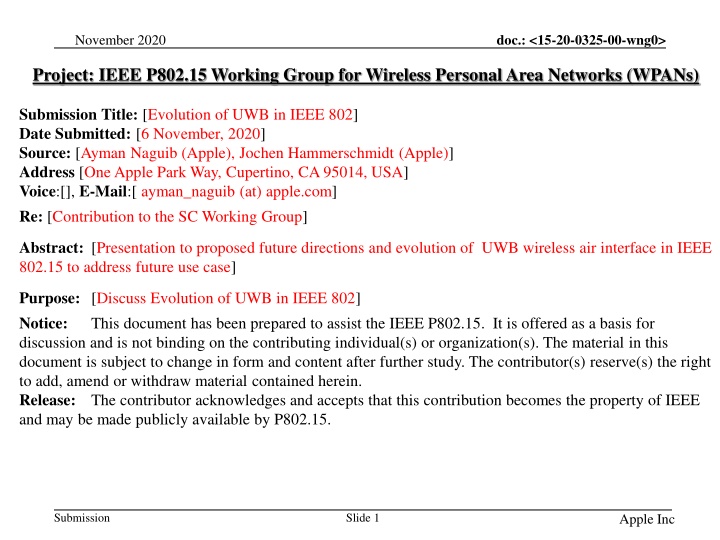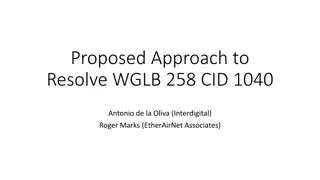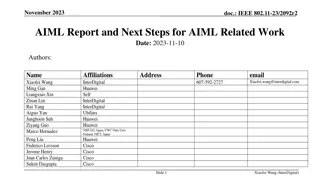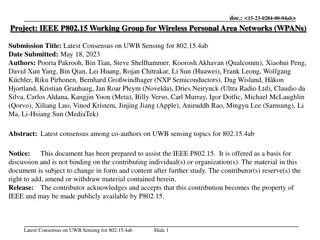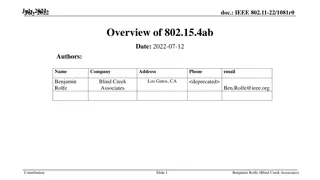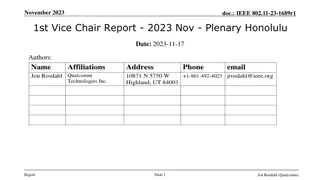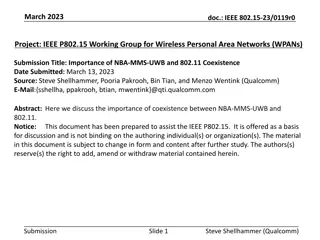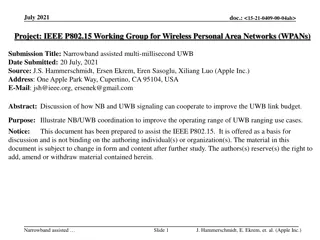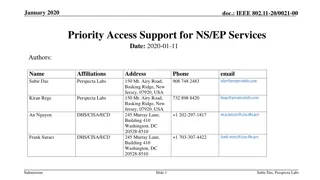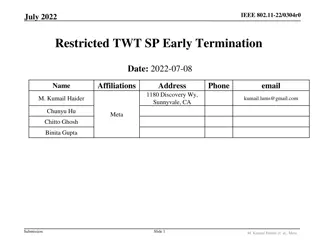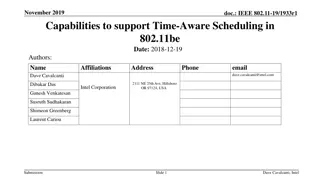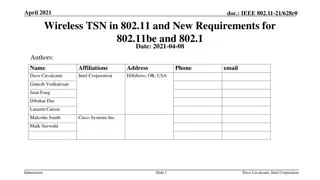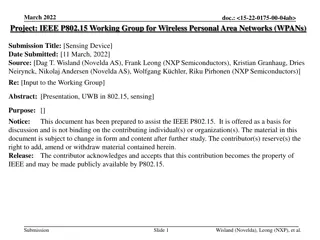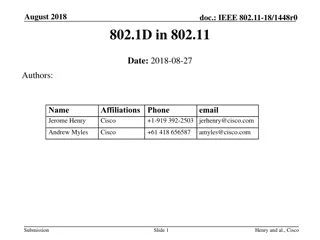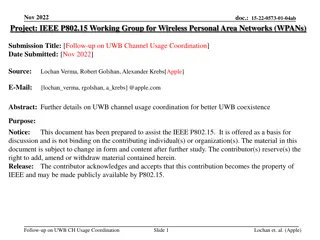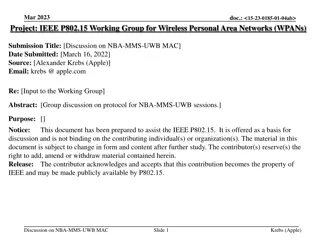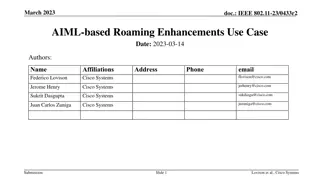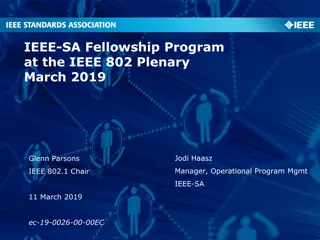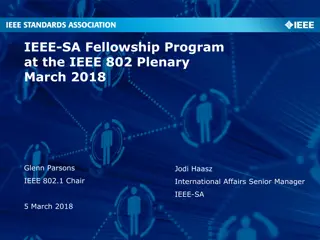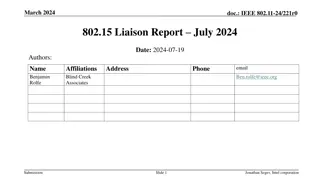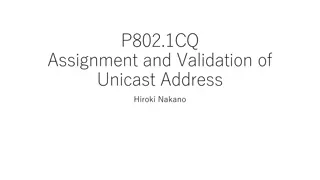Evolution of UWB in IEEE 802 - Future Directions and Enhancements
Discussing the evolution of Ultra-Wideband (UWB) technology within IEEE 802 standards, focusing on proposed future directions, improvements, and potential use cases. The presentation covers observations, trends, and spin-out strategies to enhance UWB capabilities, including advancements in PHY and MAC protocols, expansion of operating range, efficiency, and support for various applications.
Download Presentation

Please find below an Image/Link to download the presentation.
The content on the website is provided AS IS for your information and personal use only. It may not be sold, licensed, or shared on other websites without obtaining consent from the author.If you encounter any issues during the download, it is possible that the publisher has removed the file from their server.
You are allowed to download the files provided on this website for personal or commercial use, subject to the condition that they are used lawfully. All files are the property of their respective owners.
The content on the website is provided AS IS for your information and personal use only. It may not be sold, licensed, or shared on other websites without obtaining consent from the author.
E N D
Presentation Transcript
doc.: <15-20-0325-00-wng0> November 2020 Project: IEEE P802.15 Working Group for Wireless Personal Area Networks (WPANs) Submission Title: [Evolution of UWB in IEEE 802] Date Submitted: [6 November, 2020] Source: [Ayman Naguib (Apple), Jochen Hammerschmidt (Apple)] Address [One Apple Park Way, Cupertino, CA 95014, USA] Voice:[], E-Mail:[ ayman_naguib (at) apple.com] Re: [Contribution to the SC Working Group] Abstract: [Presentation to proposed future directions and evolution of UWB wireless air interface in IEEE 802.15 to address future use case] Purpose: [Discuss Evolution of UWB in IEEE 802] Notice: This document has been prepared to assist the IEEE P802.15. It is offered as a basis for discussion and is not binding on the contributing individual(s) or organization(s). The material in this document is subject to change in form and content after further study. The contributor(s) reserve(s) the right to add, amend or withdraw material contained herein. Release: The contributor acknowledges and accepts that this contribution becomes the property of IEEE and may be made publicly available by P802.15. Submission Slide 1 Apple Inc
doc.: <15-20-0325-00-wng0> November 2020 802.15.4z Time Line 802.15.4z TG started in May 2018. iOS devices supporting 802.15.4z shipping since fall 2019 CCC chooses UWB as the air interface for its DCK specifications. 802.15.4z became an official IEEE standard in May 2020 Other forums and industry groups start considering UWB for its solutions (Oct 2019) Android devices supporting 802.15.4z announced July 2020 Millions of smart portable devices devices supporting 802.15.4z are now enabling UWB applications for millions of users across the globe 802.15.4z UWB rocks Submission Slide 2 Apple Inc
doc.: <15-20-0325-00-wng0> November 2020 Future Directions for UWB (1) Observations: An emerging trend in design new wireless air interfaces is to consider Communication, Sensing, Ranging, and Control in the design of new PHY & MAC protocols to accommodate different uses cases and scenarios. 6G/5G Research 802.11 already have a new PAR for MAC & PHY changes to use WiFi for sensing New wireless air interfaces are expected to support massive number of M2M links at very low power. UWB and 4z actually already support some of that. With some further improvement and development, UWB is in a good position to address many of the CSRC use cases targeted by other air interfaces in a way that strongly integrates with and builds on current 4z deployments Submission Slide 3 Apple Inc
doc.: <15-20-0325-00-wng0> November 2020 Future Directions for UWB (2) Spin out 4z/UWB and related building blocks from 802.15.4 into self-sufficient specification to enable strong UWB centric ecosystem Example Phy & MAC improvements & feature enhancements relative to 4z baseline Enhance operating range, efficiency (complexity/power), accuracy, and integrity via suitable new waveforms and signaling techniques Improved capabilities for native discovery / connection setup Further optimized protocol framework targeting specific use cases Improved support for data-less ranging Consider proliferation of new channels / frequency bands Enhancements for Depth Sensing & Mapping Limit use of payload bearing formats to control signaling and non-streaming data applications to prevent self-cannibalization of UWB s strong nascent success Regulatory & Coexistence Considerations Submission Slide 4 Apple Inc
